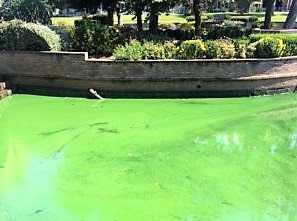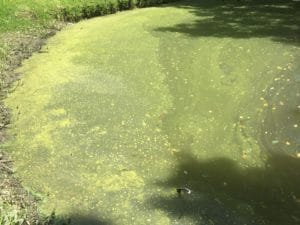Have an ugly green or yellow film covering your pond? Various types of films may periodically appear on the surface of your pond at different times of year. The most common culprits are algae commonly referred to as “pond scum”.
Planktonic and Filamentous Algae
There are a variety of algae species that manifest in different ways. Single cell, planktonic algae appears as a green film that resembles paint on the surface of the pond. Films caused by planktonic algae will briefly separate if you run your hand across the water surface. On the other hand, filamentous algae species form dense, floating mats. Various types of blue-green algae and lyngbya may appear anywhere from green, brown, blue, to black in color. Regardless of the type of algae, most can be controlled with EPA approved algaecides or nutrient reduction methods.

Planktonic algae on pond surface
Floating Aquatic Plants
The film covering your pond surface can also be floating aquatic plants. The most common in North Texas are duckweed and watermeal. These tiny plants can cover the entire water surface if left unmanaged. This completely blocks out sunlight penetration and restricts oxygen production in the pond. This can lead to the die off of fish, mollusks, and aquatic insects. Both duckweed and watermeal can be controlled using aquatic herbicides. When the pond is completely covered, it is important to treat with a slow acting, systemic herbicide in order to avoid rapid oxygen depletion.
Pollen Films
Surface films can be caused by pollen from certain varieties of trees and other terrestrial plants. Pollen films are often confused with single cell algae. The most common color of pollen is yellow; however, it can also come in red, white, and brown. Pollen films are most common from March through late October.
Small, isolated ponds that receive little wind and those without fountains or surface aeration are the most susceptible to developing pollen films. This is because the surface tension of the pond is not compromised by wave action. Calm conditions allow the pollen to remain floating on the surface for long periods of time. Unfortunately, there are no products that can be applied to prevent or eliminate pollen. The good news is that they are often controlled by Mother Nature.
How do you prevent or reduce pollen films? The most effective way is to add a surface fountain or aerator to break the surface tension of the pond.

Pollen on Pond Surface
Minimizing the amount of vegetation surrounding or overhanging the pond will help reduce pollen films. And finally, weather has the biggest effect on pollen. Heavy to moderate rainfall will break the surface tension and cause the pollen to sink. Very heavy rains may flush the pollen out of the pond completely. The good news is that pollen is not harmful to fish nor wildlife and is only seasonal in occurrence.
Other Films
Surface films appearing as rainbow colored sheens are strong indicators of oil or grease. This is common in small urban ponds designed to capture stormwater runoff from streets and other impermeable surfaces. These films are petroleum based and are typically broken down by naturally occurring bacteria that live in the pond. Only in severe cases are there potential risks to fish and wildlife.
Other films include biofilms and groundwater related films. Biofilms usually appear white and foamy; while iron rich well water can leave a red colored residue on the surface.
If you are unsure of the cause of a pond film, contact Magnolia Fisheries and have our biologists identify the culprit and provide you with a pond and lake management solution!
